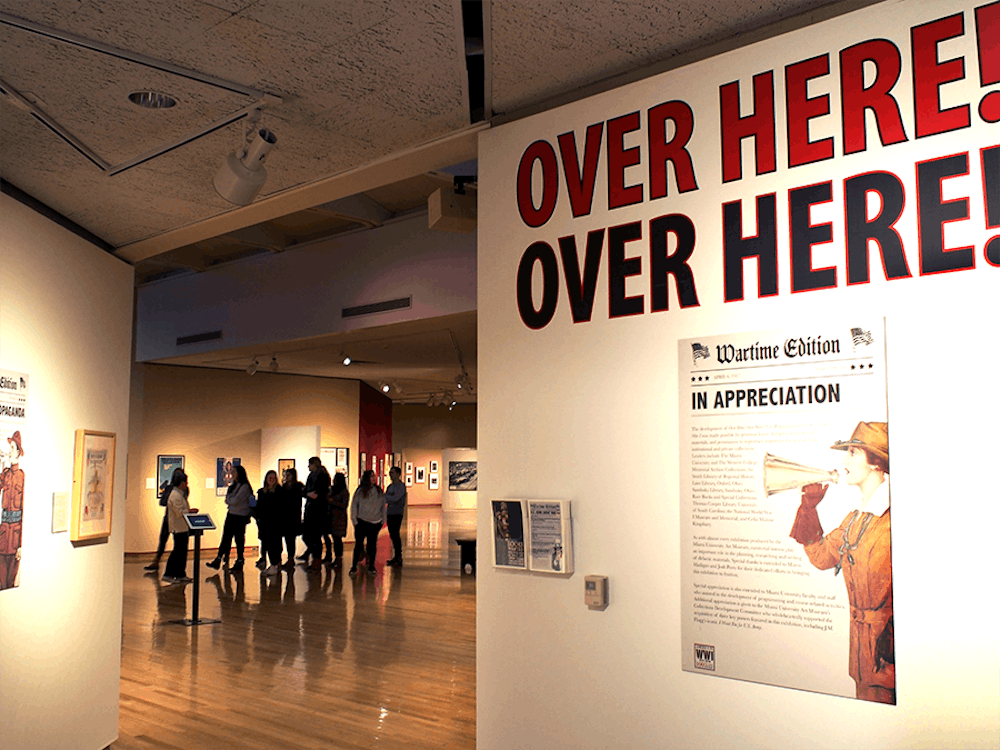Last Wednesday, approximately 25 Miami students, professors and community members, as well as one 4 Paws 4 Ability dog, gathered at the Miami University Art Museum to learn about the many uses of propaganda in World War I.
The multimedia program, entitled "For Home & Country: World War I Propaganda on the American Homefront" and hosted by Celia Kingsbury of the University of Central Missouri, was the first presentation of a series accompanying the museum's seasonal exhibition, "Over Here, Over Here! U.S. Propaganda and the Arts of World War I." The exhibition aims to honor the 100th anniversary of the U.S. entry into WWI through a variety of artifacts, presentations and connections to the current Miami and Oxford communities, according to Jason Shaiman, the curator of exhibitions at the museum.
During Kingsbury's hour-long presentation, she briefly described the origin and definitions of the term propaganda before showing over 60 images of posters, sheet music covers, cookbooks and other mediums portraying propaganda during WWI.
"World War I did not invent propaganda, but with the help of a number of skilled artists and writers, it created propaganda as we know it," Kingsbury said early in her presentation. She explained how artists such as Norman Rockwell, musicians like George M. Cohan and writers including F. Scott Fitzgerald and Ernest Hemingway all used their abilities to encourage Americans to get involved in the war effort.
Kingsbury divides WWI era propaganda into four categories: images of women, idealized iconography of soldiers, pictures of children and negative portrayals of "Huns," the dehumanized term used for Germans. Whether by encouraging women to plant victory gardens, advising children to purchase war bonds or warning Americans of the potential of a German invasion, each image was meant to personalize the war and create action at home.
Amanda Bruno, a senior political science and international studies double major with a Chinese minor, attended the event.
"I have an interest in political propaganda, its effectiveness, what it says about the society that produces it and how it is received internationally," Bruno said after the program. "My favorite part was the visuals, because I didn't know much about World War I propaganda beforehand."
Shaiman was inspired to create the seasonal "Over Here, Over Here!" exhibit after being a part of a World War I 90th Anniversary exhibit at the University of South Carolina. He was eager to showcase much of the same artwork in Oxford, along with new pieces that were specific to the Miami community.
"I think there are a lot of connections to current Miami students with our current exhibitions," Shaiman said. "With the 'Over Here, Over Here' exhibit, we tie in with the Miami and Western College for Women connections and look at what was taking place here 100 years ago."
The exhibit not only contains national pieces like the iconic "I Want You For US Army" Uncle Sam poster by J.M. Flagg, but it also holds local artifacts that Miami students will connect with, including war-oriented articles from The Miami Student and advertisements encouraging Western College students to join groups that would boost the morale of soldiers.
Shaiman hopes current students will see what their predecessors were doing to be involved, engaged and informed in their community and see the benefit of being a part of something that is larger than the university itself.
"The more that we develop exhibitions that touch different academic disciplines, the more we can engage students to come," Shaiman believed. "Our hopes are that they set foot into the museum because of class, but then they come back on their own and see the independent importance of our art and culture for themselves."
Bruno echoed his sentiments, hoping that her peers who visit the exhibit over the next few months through class or their own interests will see how propaganda has been used in the past and how to recognize it in the present.
The Miami University Art Museum has many events planned for the rest of the semester centered around the "Over Here, Over Here!" exhibition, which runs through May 13, including "Picturing Contemporary Warfare: Art in the Age of the Drone" on March 2 and a reception and program honoring the 100th anniversary of the U.S. entry into WWI on April 6.

